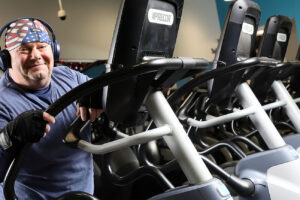Sunny summer weather means more time enjoying outdoor sports like tennis and golf. The repetitive motions these sports require, however, can make a day on the court or links a painful one. Stacey Gallacher, MD, a board-certified, fellowship-trained orthopedic surgeon on staff at CentraState Medical Center, offers the following advice about elbow tendonitis.
What is elbow tendonitis?
This relatively common condition occurs when the tendons in your forearm that attach to the bony bump on your elbow become inflamed either through injury or normal wear and tear. Tennis elbow affects the outer tendon in the elbow, while golfer’s elbow involves the inner tendon. Anyone can develop elbow tendonitis, not just those who play these sports. Any type of repetitive elbow motion—repeatedly typing on a keyboard or even using a screwdriver—can cause inflammation.
What are the symptoms?
If you have elbow tendonitis, you’ll experience pain when moving your elbow or wrist or rotating your palm up or down. You also may feel pain in your wrist and fingers. Pain is the most common symptom, followed by swelling and tenderness by the elbow bone. You may feel pain intermittently or constantly, depending on the severity of the injury.
When should someone see a doctor about elbow pain?
I suggest that patients try icing and resting the elbow and taking over-the-counter anti-inflammatories like ibuprofen first. If you still feel pain after a week, you should contact a physician. Don’t just push through the pain, particularly if you feel sharp, severe pain that doesn’t feel like a sore muscle. By resting your elbow at the first sign of pain, you’re giving your body the best chance to heal—and you may avoid more invasive treatment.
How are tennis elbow and golfer’s elbow treated?
I start with conservative treatments, like anti-inflammatories, physical therapy, or bracing the elbow. If these methods don’t provide relief, I’ll request an advanced imaging study of the elbow, usually an MRI, to see if there’s any tearing of the tendon, which typically doesn’t heal on its own. If a patient is still feeling pain after a few weeks of conservative treatment, I know the injury is more severe. In those cases, I’ll perform minimally invasive arthroscopic surgery to debride, or clean up, the damaged portion of the tendon. Because this surgical technique uses a smaller incision than traditional surgery, patients recover quicker and can participate in the activities they enjoy in five to six weeks.
How can these conditions be prevented?
You can protect yourself from elbow injuries by warming up and stretching properly before playing sports or doing other activities that require repetitive motion. For sports in particular, be sure to focus on using the proper techniques and form to prevent injury.
For more information about CentraState’s orthopedic surgery services, call 866-CENTRA7.





